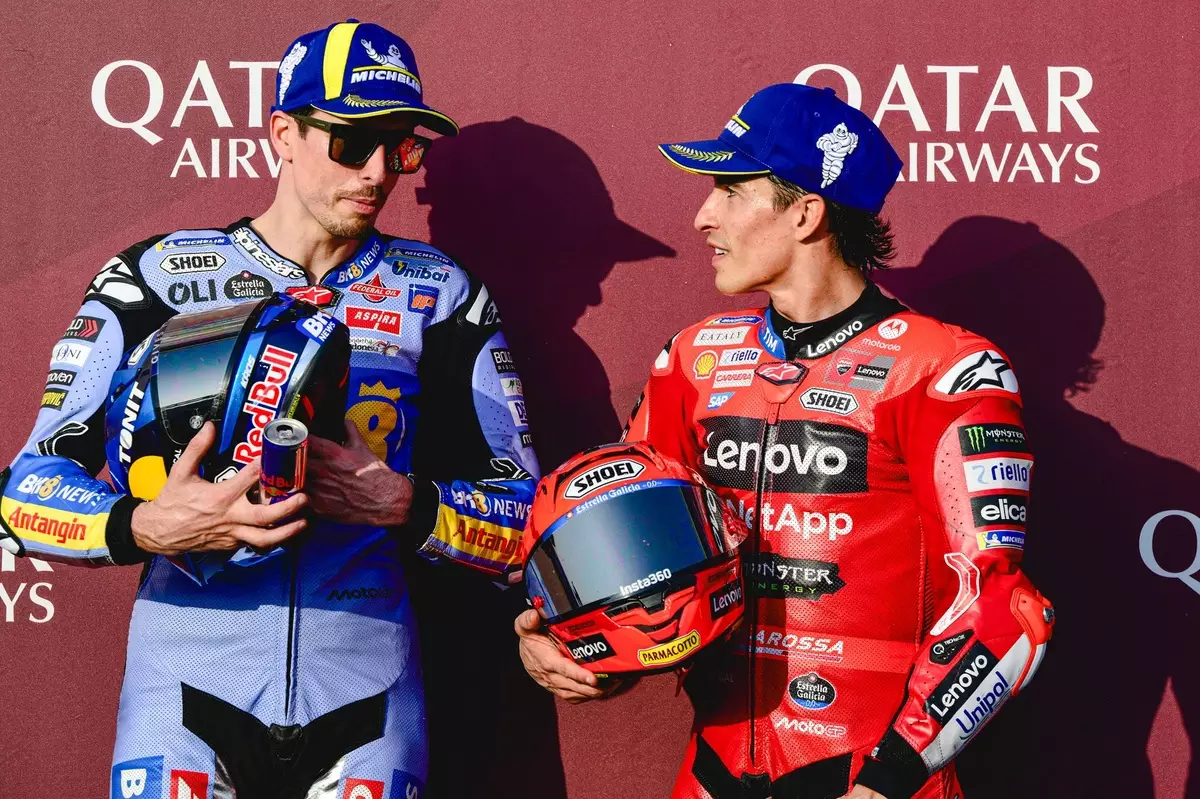During the recent Qatar Grand Prix, a seemingly innocuous moment transformed into a pivotal incident, highlighting the razor-thin margin that separates triumph from turmoil in MotoGP. Marc Marquez, a name synonymous with speed and skill, found himself at the center of a controversy involving his younger brother, Alex Marquez. As they exited the first corner of the race—a critical moment of strategy and speed—Marc’s decision to cut across Alex’s path resulted in a physical clash. This incident didn’t just impede their performance on the track; it underscored the psychological and competitive dynamics that unfold in high-stakes racing.
Marc, uncharacteristically candid in admitting his role in the collision, noted that his hesitation in acceleration was an unexpected factor for Alex. This moment of miscalculation disrupted not only their race but also allowed Franco Morbidelli from VR46 to seize an opportunity to take the lead. Such instances resonate deeply in the racing community, where each rider’s move can ripple through the standings, sometimes with catastrophic effects.
The Ripple Effects of Competitive Pressure
The fallout from this incident rippled beyond the initial collision as Alex’s race spiraled into further complications. Struggling to regain lost momentum—now a key aspect of a rider’s psyche—he attempted to re-overtake Fabio di Giannantonio, resulting in yet another collision. This second misstep led to a long-lap penalty, effectively ending his chances of a strong finish and leaving him seventh.
The internal rivalry between the Marquez brothers adds another layer to this narrative. Initially, Alex was only two points behind Marc but found himself trailing by 17 points after the race. This drama isn’t just about numbers; it’s about the emotional weight that carries for athletes striving for excellence. The pressures of performing at this level are immense, and the need to reclaim lost positions can lead to risky decisions, as evident in Alex’s actions.
Responsibility and Reflection in Racing
Both brothers took responsibility for their respective errors, portraying a mature perspective on accountability—not just as competitors, but as individuals navigating their professional journeys. Marc’s forthright admission of his initial mistake reflects a deep-seated understanding that growth in any field requires acknowledgment of one’s errors. Racing is not merely a test of speed; it’s a high-octane battlefield where strategic thinking and emotional resilience are vital.
Alex’s reflections on his collision with di Giannantonio further illustrate this principle. He recognized his mistake and expressed a desire for reconciliation, showcasing the respect that exists among riders—even when fierce competitiveness prevails. “It was my mistake, it’s my responsibility,” he remarked, embodying the dignity found in accepting failure as part of a larger journey.
High Stakes and High Emotions
The world of MotoGP is a unique blend of incredible engineering, sheer athletic prowess, and intense psychological pressure. Each race serves as a reminder that a split-second decision can alter the course of an entire season. Drivers not only battle for points and positions but also contend with their emotions, crafting narratives that are compelling both on and off the track.
Di Giannantonio’s frustration following the race echoed the broader sentiment among riders who find themselves on the were on the receiving end of such collisions. His observations about the distinctions between various levels of racing highlight an important truth: MotoGP athletes must engage not just their physical talents but also their mental finesse to mitigate risks effectively.
In the end, the Qatar Grand Prix served as a stark reminder of MotoGP’s unpredictable nature. It is a constant balancing act—a dance between aggression and caution, skill and strategy. As the race unfolded, both triumph and tragedy were on display, setting the stage for future races where lessons learned on the track can culminate in greater wisdom and perhaps, eventual victory.


Leave a Reply